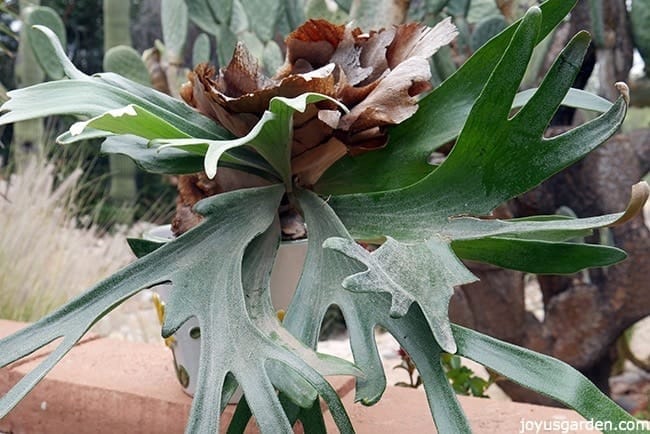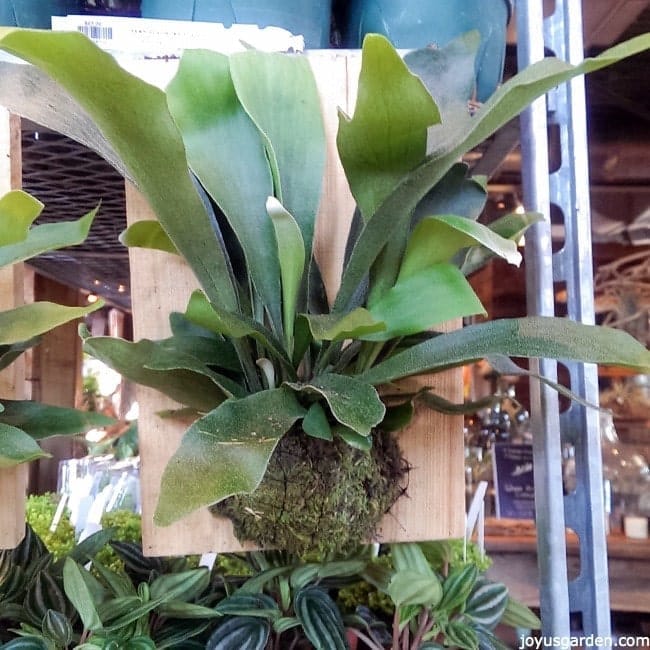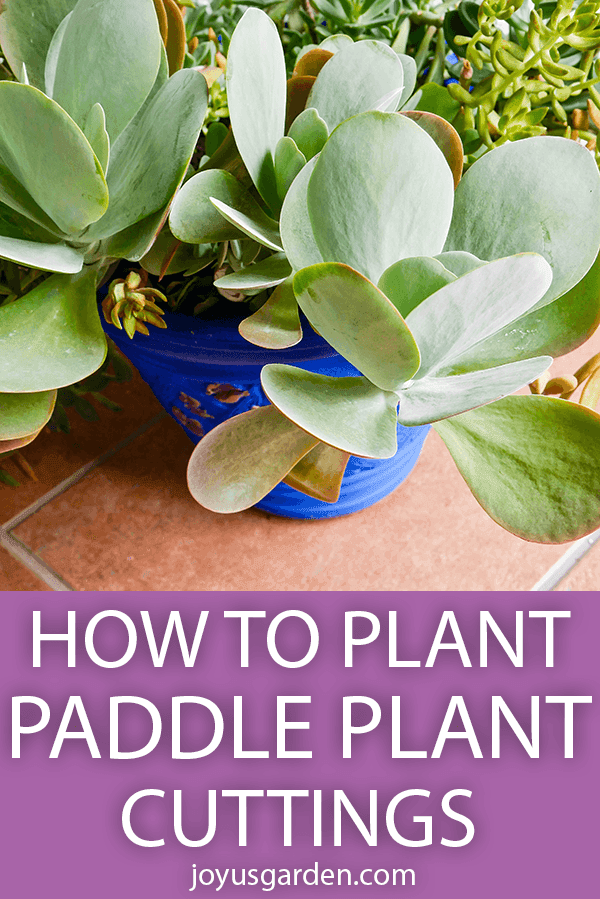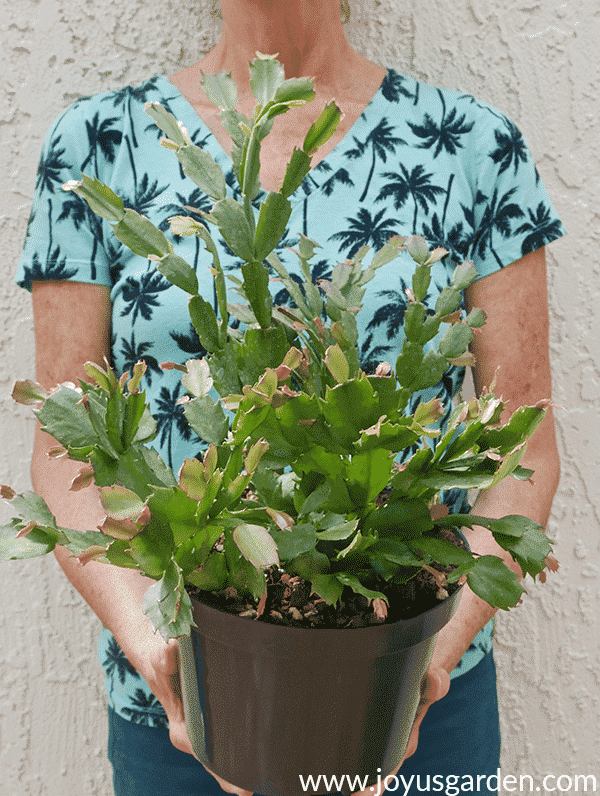How To Grow A Staghorn Fern Indoors
I’m serving up buckets of artsy plant fun here: Staghorn Ferns are just the right amount of cool with a dash of wackiness thrown in. They’re epiphytes, just like orchids and bromeliads, which means they grow on other plants in their native environment, which is the tropical rainforest. They do great outdoors in temperate climates but also make fine houseplants with a little effort. This is all about how to grow a Staghorn Fern indoors, even though are homes are nothing like the rainforest.
Staghorn Ferns can be grown in a pot, in a wire basket as well as on a wire frame. They’re commonly seen growing on a piece of wood, like a hunk of bark, driftwood or a tree branch. These epiphytes prefer to grow this way because it allows for maximum air circulation which is something they love.
Some Of Our General Houseplant Guides For Your Reference:
- 3 Ways To Successfully Fertilize Indoor Plants
- How to Clean Houseplants
- Winter Houseplant Care Guide
- Plant Humidity: How I Increase Humidity For Houseplants
- Buying Houseplants: 14 Tips For Indoor Gardening Newbies
- 11 Pet-Friendly Houseplants
Things you need to know to grow a Staghorn Fern:
Exposure
Staghorn Ferns like bright, natural light but no direct sun. They typically grow under the canopies of trees which provide light shade. An east exposure in your home is fine as well as west or south but with these last 2, make sure your fern is at least 10′ away from a hot window. Conversely, if the light is too low, it’ll slowly decline. In the winter when the light levels are lower, you might have to move it to a brighter spot.
Watering
This is the most challenging care point for most people as they like to be kept evenly moist but not soaking wet. Because they’re epipyhtes, their roots really need to breathe. Just think of how they get watered in the rainforest where it rains a lot but they’re somewhat protected by the plants growing above: it rains, they take what moisture they need & then it all drains off. Remember, they’re growing attached to other plants up off the ground.
As a general rule of thumb, watering a Staghorn Fern every 7-10 days is the way to go. In the winter, water less. If yours is growing on wood, take it to the sink & run water over it & let it all drain out. These ferns absorb water through their leaf fronds & shield fronds as well as their roots so you want to make sure to wet all parts. The other thing you can do is turn it face down & soak it for 10 minutes or so.
Head’s up: speaking of those shield fronds (the dried mass the leaf fronds emerge from), don’t remove any any of them even though you might be tempted to by their “dead looking” appearance. They anchor & protect the plant.
My Staghorn Fern grows in a pot. I water it by pouring a good amount of water over the leaf & shield fronds & lightly watering the roots.

Here you can really see those dry shield fronds. By the way, the leaf fronds have a waxy somewhat fuzzy coating which they need. Don’t try to wipe it off!
Humidity
The humidity levels in the rainforests are over 70%. Unless you live in the tropics or subtropics, the humidity level in your home will be a lot less. Because I live in the desert, I run water over the leaf & shield fronds (not the soil) every 2-3 days. Your Staghorn Fern would appreciate a good misting every few days to up the ante a wee bit on the humidity level.
Fertilizing
When growing outdoors, Staghorn Ferns get their nourishment from organic matter which falls on them from the plants above. Indoors, this plant would like to be fed a few times a year in spring, summer & early fall. I’ve used a balanced orchid fertilizer diluted to 1/2 strength which I poured over the leaf & shield fronds as the roots. You can also use a fertilizer formulated for air plants.
I know someone who uses liquid kelp fertilizer on his Stag Ferns & they’re doing great. There’s also info floating around about banana peels tucked into the shield fronds but I’ve never tried that. I imagine a dead & decaying peel might attract fruit flies but maybe not. Let me know if this method has worked for you indoors!
Temperature
As I always say, if your house is comfortable for you, then your plants will be comfortable too. My Staghorn Fern is growing outdoors here in Tucson but I have plans on moving it inside very soon. It made it through the winter with a 9 or 10 nights around freezing but the hot, dry summer temps. are rough on it.
Pests
Mine have never gotten any but I’ve heard they can get scale. I’d recommend removing them by hand or with a cotton swab but I’ve done a post here with more info on this pest.
Soil
If your Staghorn Fern is growing on wood, then sheet moss is most likely it’s growing medium. If yours is in a pot like mine, then the water must readily drain out which means never use straight potting soil. I used a mix of 1/2 succulent & cactus mix & 1/2 orchid bark for mine in pots.

Here’s 1 mounted & growing on wood in case you haven’t seen something like this before.
A few reasons Staghorn Ferns can be a challenge when grown indoors:
1- The light level is too low.
2- They get overwatered.
3- Not enough humidity.
4- Poor air circulation.

This gorgeous Staghorn Fern grows at Lotusland in Montecito, CA. You can see how big they really get!
If you’re interested in giving this artistic and unusual plant a try, here’s a source for 1 mounted on wood as well as 1 in a pot.
The first time I saw a Staghorn Fern mounted on wood my heart went pitter-patter. And it still does!
Happy gardening,

YOU MAY ALSO ENJOY:
- Repotting Basics: Basics Beginning Gardeners Need To Know
- 15 Easy To Grow Houseplants
- A Guide To Watering Indoor Plants
- 7 Easy Care Floor Plants For Beginning Houseplant Gardeners
- 10 Easy Care Houseplants For Low Light

This post may contain affiliate links, you can read our policies here.
- About the Author
- Latest Posts
Nell, the founder of Joy Us garden, was born into a gardening family and grew up in Connecticut’s countryside. After living in Boston, New York, San Francisco, & Santa Barbara, she now calls the Arizona desert home. She studied horticulture & garden design, working in the field all her life. Nell is a gardener, designer, blogger, Youtube creator, & author. She’s been gardening for a very long time & wants to share what she’s learned with you.








Thanks for posting the how to on mounting a potted staghorn! I followed it and it looks great!
Danielle – Good to hear! I love Staghorns, especially mounted. Nell
Do I need to mix the cactus/succulent potting mix with the bark or layer one on top of the other? Thanks for your help!
I mix them McKenzie. Hope that helps! Nell
I just potted my 1st staghorn fern following your soil directions. I am now ready to fertilize it with an orchid fertilizer you suggested at 1/2 strength. How much is to be used on the plant at each of its feedings?
Allyson – The amount you use depends on the pot size. Just follow the amount recommended on the fertilizer box or tub. Nell